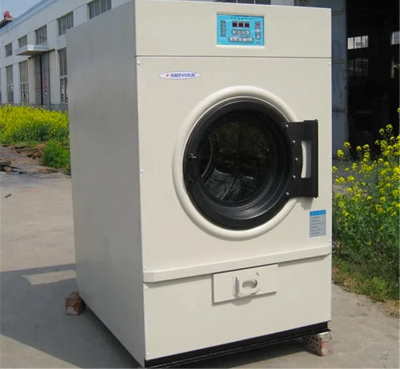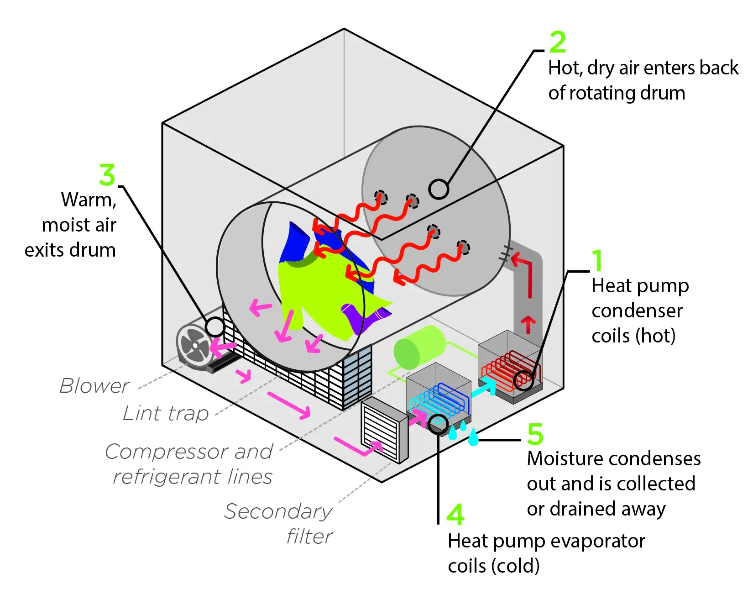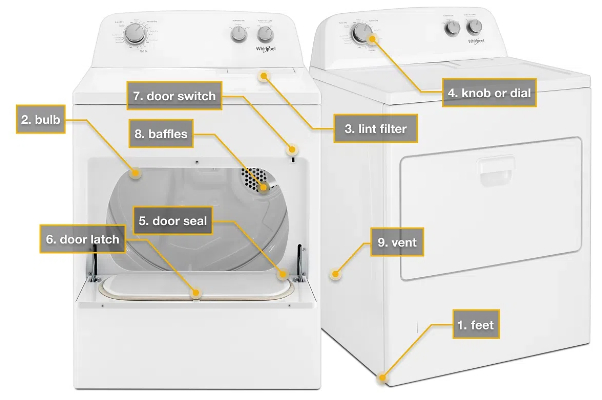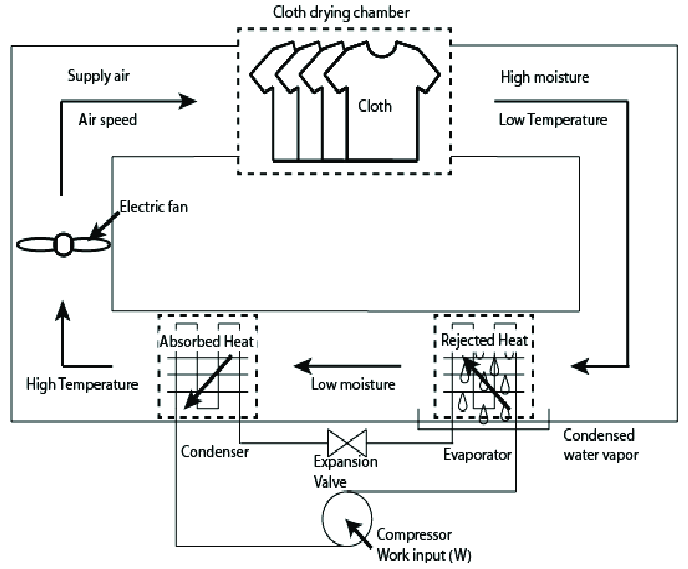
Content Menu
● Introduction
● The Basic Principle of Electric Dryers
● Key Components of an Electric Dryer
>> 1. Drum
>> 2. Heating Element
>> 3. Blower or Fan
>> 4. Thermostat and Temperature Control
>> 5. Timer and Control Panel
>> 6. Lint Filter
>> 7. Moisture Sensors
● How Does an Electric Dryer Work: Step-by-Step Process
>> Step 1: Power Up and Settings Selection
>> Step 2: Drum Rotation Begins
>> Step 3: Heating Element Activation
>> Step 4: Hot Air Circulation
>> Step 5: Moisture Extraction
>> Step 6: Moist Air Removal
>> Step 7: Exhaust
>> Step 8: Cycle Completion
● Energy Efficiency in Electric Dryers
>> 1. Moisture Sensors
>> 2. Heat Pump Technology
>> 3. Energy Star Certification
>> 4. Multiple Heat Settings
● Electric vs. Gas Dryers: A Comparison
>> Electric Dryers:
>> Gas Dryers:
● Maintenance Tips for Electric Dryers
>> 1. Clean the Lint Filter
>> 2. Check and Clean the Exhaust Vent
>> 3. Inspect the Drum Seal
>> 4. Clean the Moisture Sensors
>> 5. Check the Drive Belt
● Troubleshooting Common Electric Dryer Issues
>> 1. Dryer Not Heating
>> 2. Clothes Taking Too Long to Dry
>> 3. Dryer Making Unusual Noises
>> 4. Dryer Stopping Mid-Cycle
● The Future of Electric Dryer Technology
● Conclusion
● Frequently Asked Questions
>> Q1: How much electricity does an electric dryer use?
>> Q2: Can I install an electric dryer myself?
>> Q3: How long should an electric dryer last?
>> Q4: Why does my electric dryer take so long to dry clothes?
>> Q5: Are electric dryers safe to use overnight?
Introduction
Electric dryers have become an essential appliance in many households, offering convenience and efficiency in our daily lives. But have you ever wondered about the intricate mechanisms that make these machines work? In this comprehensive guide, we'll explore the fascinating world of electric dryers, delving into their components, functions, and the science behind their operation.
The Basic Principle of Electric Dryers
At its core, an electric dryer operates on a simple principle: it uses electricity to generate heat and power a fan that circulates hot air through wet clothes, evaporating the moisture and leaving them dry. This process involves several key components working in harmony to achieve efficient drying.
Key Components of an Electric Dryer
1. Drum
The drum is the heart of the dryer, where clothes are tumbled. It's typically made of stainless steel or coated metal and features small holes or perforations that allow hot air to circulate through the clothes.
2. Heating Element
The heating element is responsible for generating the hot air needed for drying. It consists of metal coils that heat up when electricity passes through them, much like the elements in an electric oven.
3. Blower or Fan
The blower or fan is crucial for circulating hot air through the drum and expelling moist air from the dryer. It creates the airflow necessary for efficient drying.
4. Thermostat and Temperature Control
These components regulate the temperature inside the dryer, ensuring clothes are dried efficiently without overheating. The thermostat monitors the temperature and signals the heating element to turn on or off as needed.
5. Timer and Control Panel
The timer and control panel allow users to select different drying cycles and settings based on fabric type and moisture level. Modern dryers often feature digital controls and multiple preset programs.
6. Lint Filter
The lint filter captures loose fibers and debris from clothes, preventing them from clogging the exhaust system and maintaining efficient airflow.
7. Moisture Sensors
Many modern electric dryers are equipped with moisture sensors that detect the level of moisture in the clothes and adjust the drying time accordingly, improving energy efficiency.

How Does an Electric Dryer Work: Step-by-Step Process
Step 1: Power Up and Settings Selection
When you turn on the dryer and select a cycle, electricity begins flowing to the various components. The control panel processes your selections and prepares the machine for operation.
Step 2: Drum Rotation Begins
The electric motor starts spinning the drum, tumbling the clothes. This motion helps to separate the clothes and expose all surfaces to the hot air.
Step 3: Heating Element Activation
Electricity flows through the heating element, causing it to heat up rapidly. As air passes over the hot coils, it warms up to the temperature set by the thermostat.
Step 4: Hot Air Circulation
The blower or fan system forces the heated air into the drum, where it comes into contact with the wet clothes. The perforations in the drum allow the hot air to penetrate the fabric.
Step 5: Moisture Extraction
As the clothes tumble in the hot air, moisture evaporates from the fabric. The tumbling action helps to separate clothes and ensure even drying.
Step 6: Moist Air Removal
The now-moist air is drawn out of the drum by the blower, passing through the lint filter to remove any loose fibers.
Step 7: Exhaust
Finally, the moist air is expelled from the dryer through the exhaust vent, typically located at the back of the machine.
Step 8: Cycle Completion
The process continues until the preset time is reached or, in dryers with moisture sensors, until the clothes reach the desired level of dryness.
Energy Efficiency in Electric Dryers
Energy efficiency is a crucial consideration for electric dryers, as they can consume a significant amount of electricity. Modern electric dryers incorporate several features to improve their energy efficiency:
1. Moisture Sensors
These sensors detect the moisture level in clothes and automatically stop the cycle when clothes are dry, preventing over-drying and saving energy.
2. Heat Pump Technology
Some high-efficiency electric dryers use heat pump technology, which recycles hot air instead of venting it outside. This can significantly reduce energy consumption.
3. Energy Star Certification
Look for dryers with Energy Star certification, which meet strict energy efficiency guidelines set by the U.S. Environmental Protection Agency and the Department of Energy.
4. Multiple Heat Settings
Different fabrics require different heat levels. Using the appropriate heat setting can save energy and protect your clothes.

Electric vs. Gas Dryers: A Comparison
While this article focuses on electric dryers, it's worth briefly comparing them to their gas counterparts:
Electric Dryers:
- Easier and less expensive to install
- Generally cheaper to purchase
- Require a 240-volt outlet
- May have higher operating costs depending on electricity prices
Gas Dryers:
- Require a gas line and proper venting
- More expensive upfront but often cheaper to operate
- Typically dry clothes faster
- May be more energy-efficient in some regions
The choice between electric and gas often depends on your home's existing infrastructure and local utility costs.
Maintenance Tips for Electric Dryers
Proper maintenance is key to ensuring your electric dryer operates efficiently and safely. Here are some essential maintenance tips:
1. Clean the Lint Filter
Clean the lint filter after every use. This simple habit ensures optimal airflow, improves drying efficiency, and reduces fire risk.
2. Check and Clean the Exhaust Vent
Periodically check and clean the exhaust vent to ensure it's free from lint buildup. A clogged vent can reduce efficiency and pose a fire hazard.
3. Inspect the Drum Seal
Check the seal around the drum periodically and replace it if it shows signs of wear. A damaged seal can allow heat to escape, reducing efficiency.
4. Clean the Moisture Sensors
If your dryer has moisture sensors, clean them occasionally with a soft cloth to ensure accurate readings.
5. Check the Drive Belt
Listen for unusual noises that might indicate a worn drive belt. If you suspect an issue, have it checked by a professional.
Troubleshooting Common Electric Dryer Issues
Even with proper maintenance, you may encounter issues with your electric dryer. Here are some common problems and potential solutions:
1. Dryer Not Heating
- Check if the heating element is functioning
- Ensure the thermostat is working correctly
- Verify that the dryer is receiving the correct voltage
2. Clothes Taking Too Long to Dry
- Clean the lint filter and exhaust vent
- Avoid overloading the dryer
- Check for a malfunctioning heating element
3. Dryer Making Unusual Noises
- Inspect the drum support rollers and axles
- Check the idler pulley and drive belt
- Ensure items in pockets aren't causing the noise
4. Dryer Stopping Mid-Cycle
- Check for overheating (which can trigger a safety shutoff)
- Ensure the door switch is functioning correctly
- Verify that the control board is not malfunctioning
The Future of Electric Dryer Technology
As technology advances, we can expect to see continued innovations in electric dryer design:
1. Smart connectivity for remote operation and monitoring
2. Advanced sensors for even more precise drying
3. Improved energy efficiency through new heating technologies
4. Integration with other smart home systems
5. More eco-friendly designs and materials
Conclusion
Electric dryers, while seemingly simple, are marvels of engineering that combine heat, airflow, and motion to efficiently dry our clothes. Understanding how they work can help you use your dryer more effectively, troubleshoot issues, and make informed decisions when purchasing a new appliance. As technology continues to evolve, we can look forward to even more efficient and convenient electric dryers in the future.

Frequently Asked Questions
Q1: How much electricity does an electric dryer use?
A1: The electricity consumption of an electric dryer varies depending on its size, efficiency, and usage patterns. On average, an electric dryer uses between 2 to 6 kilowatt-hours (kWh) of electricity per cycle. Energy Star certified models tend to use less energy, potentially saving you money on electricity bills.
Q2: Can I install an electric dryer myself?
A2: While it's possible to install an electric dryer yourself if you have a 240-volt outlet available, it's generally recommended to have a professional do the installation. This ensures that the dryer is properly connected and meets all safety requirements. Improper installation can be dangerous and may void your warranty.
Q3: How long should an electric dryer last?
A3: With proper maintenance, an electric dryer can last 10-13 years on average. However, this can vary depending on the quality of the machine, how frequently it's used, and how well it's maintained. Regular cleaning and timely repairs can help extend the life of your dryer.
Q4: Why does my electric dryer take so long to dry clothes?
A4: Several factors can cause longer drying times:
- A clogged lint filter or exhaust vent
- Overloading the dryer
- A malfunctioning heating element
- Using the wrong cycle for the type of clothes
- Low voltage supply to the dryer
Check these potential causes and clean or repair as necessary. If problems persist, consider calling a professional for a diagnostic check.
Q5: Are electric dryers safe to use overnight?
A5: While modern electric dryers have multiple safety features, it's generally not recommended to run your dryer overnight or when you're not at home. There's always a small risk of fire, especially if lint has built up in the dryer or vent. For safety, it's best to operate your dryer when you're awake and at home.












